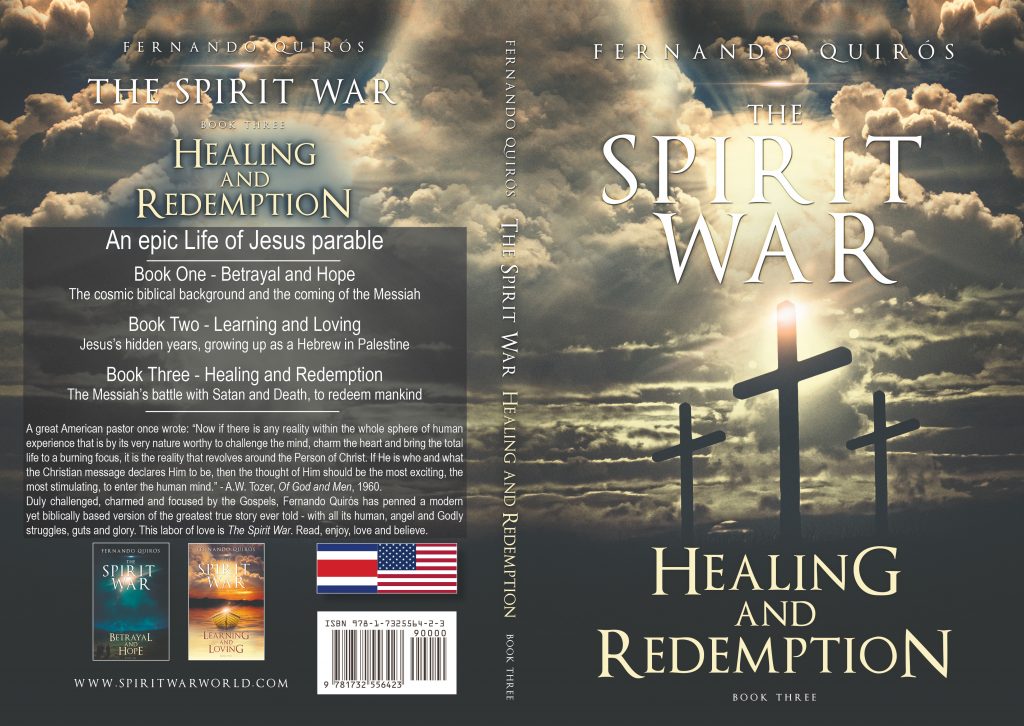
When this author was first inspired by the story of Jesus in Gospels in modern English, this is the book I thought had to be out there, somewhere. But after searching for 20 years, and not finding it, I set out to write my own.
The Spirit War challenge was intimidating. How do you tell the Greatest True Story Ever Told as it deserves? The epic scale, with so many characters who actually lived, would require a daunting amount of background and setting up. So much so that one book turned into a trilogy. Two preceding volumes were required to fully develop the background, context and characters.
With Healing and Redemption, The Spirit War now arrives at the point where necessary preparations are finally in place. Book 1, Betrayal and Hope, has developed the cosmic context, as well as telling the Nativity story. Book 2, Learning and Loving, has completed the large cast. Each main character has been brought to the point in his or her life where Jesus is revealed as the Messiah. The Christ now begins the earthly, public part of His cosmic mission.
Scripture quote footnotes will show just how much of Healing and Redemption is lifted straight from the Gospels. Book 1 and Book 2 of The Spirit War had 74 Bible reference footnotes between them. Book 3 alone has 138.
Buckle up, readers. Healing and Redemption’s 308 pages will whiz by even faster than for the first two, shorter Spirit War books.
Large sections of dialogue in Healing and Redemption will be familiar to Gospel readers. Outstanding sections directly quoted include the entire Sermon on the Mount from Matthew, and Jesus’s adversarial dialogues with temple priests and rabbis from John. The relevancy for our time of teachings and arguments that took place 2100 years ago may surprise modern readers.
The Messiah’s outreach to the world starts in light, with Jesus’s joy in curing, caring for and teaching his flock. But it gets dark quickly. Jesus pushes, by healing and mercy towards the sick and poor and needy. The priestly establishment pushes back, threatened by a Prophet who bluntly exposes their hypocrisy. Meanwhile Satan bides his time. The Devil is sure that his ultimate weapon, Death, is stronger than the Jewish God and His Son.
The Crucifixion is taken to a whole different level, as a direct duel between the Son of God and Satan. An unfair duel, in which the Devil got to choose crucifixion as his weapon. But in spite of its horror, the crucifixion was not the end, but the beginning. A triumphant reckoning follows, to which the phrase “all Hell breaks loose” applies literally.
The word Gospel means good news. If you think happy endings are banal or unrealistic, then Healing and Redemption might not be for you. The Gospel message is that the Messiah suffered as a means to glorious victory, and that He invites each of us to share in that triumph. This worldview – which many modern readers consider too good to be true – is precisely what has given the Message its staying power over the centuries.
In Book 3 Jesus’s loved ones and disciples must each fight his or her individual spirit war. All are challenged to hold love and hope over hate and fear. All, both angel and human, break through from darkness to light – along with their victorious, risen, alive forever Redeemer.
As a complement to the Gospels, the purpose of The Spirit War is to make a simple but compelling case for faith in Jesus Christ as the Son of God and the Redeemer of us all. Should you choose to enjoy The Spirit War apart from the Good News Books, Healing and Redemption will show you every important person and event concerning Jesus’s earthly ministry that is in those Gospels.
Quotes from Spirit War readers on Amazon
“For those of you who think of Jesus as the Son of God, for those who love fantasy with all their heart, for those looking for a new perspective on an age-old story, THE SPIRIT WAR is the trilogy you’re looking for, and HEALING AND REDEMPTION is a worthy conclusion to a sprawling, epic labor of love.”
“Although Part 3 of The Spirit War trilogy is the longest book at 308 pages, it’s a page-turner that goes by even faster than the previous, shorter works. As in Book 1, well-known Christian tradition – now the Gospel stories – is amplified into multi-dimensional worlds. From Book 2, the love relationships are deepened and perfected, and resolved not just for this life, but for eternity. And as in both, the skill with which the tale is told is as important as the plot.”